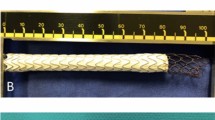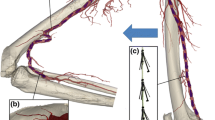Abstract
Purpose: To assess selected balloon-expandable and self-expanding stents for radial force, flexibility, radio-opacity, and trackability, and to relate these physical characteristics to potential indications for placement.
Methods: Force-strain curves were plotted for each stent and the force required to produce 50% luminal narrowing was recorded. The ability of the stent to show elastic recoil following deformation was also noted. Flexibility was measured by bending the stents against a force transducer and recording the force required per degree of flexion. Radio-opacity was measured by comparing each stent against a standard aluminum step wedge. Trackability was measured by testing the ability of the stent on its delivery system to track over angles of 90° and 60°.
Results: The balloon-expandable stents showed greater radial strength and radio-opacity but, apart from the AVE Iliac Bridge stent, showed poorer flexibility and trackability. The self-expanding stents showed less radial force but were able to re-expand following deformity. They were generally more flexible and had better trackability but lower radio-opacity.
Conclusion: There is no stent which exhibits all the ideal properties required and therefore the interventionist will need to keep a range of stents available if all lesions are to be addressed.
Similar content being viewed by others
References
Lossef S, Lutz R, Mundorf J, Barth K (1994) Comparison of mechanical deformation properties of metallic stents with use of stress-strain analysis. J Vase Interv Radiol 5:341–349
Berry JL, Newman VS, Ferrario CM, Routh WD, Dean RH (1996) A method to evaluate the elastic behaviour of vascular stents. J Vase Interv Radiol 7:381–385
Flueckiger F, Sternthal H, Klem GE, Aschauer M, Szolar D, Klemhappl G (1994) Strength, elasticity and plasticity of expandable metal stents: In vitro studies with three types of stress. J Vase Interv Radioi 5:745–750
Oberg E, Jones FD, Horton HL (1984) Strength of materials. In: (ed) Machinery’s Hand Book, 22nd revised edn. Industrial Press, New York, pp 240–241
Gotman I (1997) Characteristics of metals used in implants. J Endourol 11:383–389
Shabalovskaya SA (1996) On the nature of the biocompatibility and on medical applications of N1T1 shape, memory and superelastic alloys. Biomed Mater Eng 6:267–289
Ryhanen J, Nicmi E, Serlo W, Niemela E, Sandvik P, Pernu H, Salo T (1997) Biocompatibility of nickel-titanium shape memory metal and its corrosion behaviour in human cell cultures. J Biomed Mater Res 35: 451–457
Palmaz JC, Windeler SA, Garcia F, Tio F, Sibbitt RR, Renter S (1986) Atherosclerotic rabbit aortas: Expandible intraluminal grafting. Radiology 160:723–726
Author information
Authors and Affiliations
Rights and permissions
About this article
Cite this article
Dyet, J.F., Watts, W.G., Ettles, D.F. et al. Mechanical properties of metallic stents: How do these properties influence the choice of stent for specific lesions?. Cardiovasc Intervent Radiol 23, 47–54 (2000). https://doi.org/10.1007/s002709910007
Issue Date:
DOI: https://doi.org/10.1007/s002709910007




